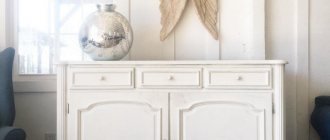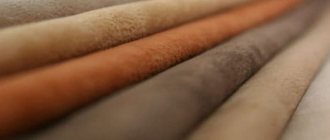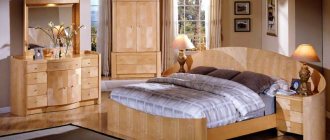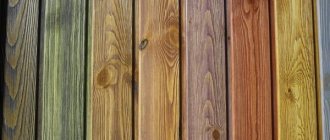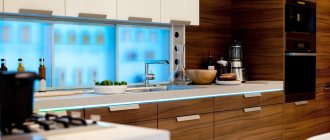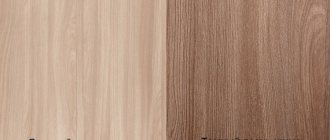54607
Modern manufacturers create original pieces of furniture from a wide variety of materials: plywood, chipboard, MDF, plastic, metal. However, natural wooden furniture remains a classic option. Furniture sets made from alder wood are incredibly popular. We invite you to find out how beautiful, functional and elegant alder furniture color photo can be, and also read tips from experienced designers on combining such furniture with room decoration.
General information about the Alder tree
Appearance of the plant
It is a shrub (up to 15 meters) or a deciduous tree growing up to 80 meters in height.
Flowering begins very early in the spring, along with birch, while the leaves have not yet blossomed.
Pollen is dispersed by the wind.
If the birch tree is covered with a green haze at this time, then the alder becomes red.
Bloom. When you get close to the tree, you can see the brown-red catkins on the bare branches.
A little time will pass (only 2-3 days) and the earrings will lengthen, their scales will bend, and the air around the tree will be saturated with yellowish pollen, which is knocked out of the earrings by the wind.
This pollen falls on small reddish flowers, similar to spikelets with pistils, of a neighboring tree - this is how the birth of a new life occurs.
Fruit. First, green cones ripen, and they contain seeds that look like nuts. Immediately after pollination, resin is poured into the cones and they are sealed. In the summer, seeds ripen in them, and in the fall the cones become woody.
The fruit is a single-seeded, flattened, small nut with two lignified stigmas bordered by a narrow wing made of film.
The nuts ripen in the cones until autumn, and then fall out of the cones and spread due to wind and water. The period of “self-seeding” lasts until spring. Cones, even without seeds, remain on the tree for a long time and disappear into the winter.
The early flowering of alder is due to the fact that the tree prepared for the coming season last fall.
In mid-summer, male catkins begin to form on the branches and grow until frost, and go into winter fully formed (they also contain a supply of pollen) and ready to fulfill their purpose.
Conditions for growth
Alder is not picky about environmental conditions , although it prefers moist soil, which is why it can be found mostly near bodies of water. But at the same time it is resistant to drought and wind and has good winter hardiness.
It loves well-lit places , so it grows better in single plantings than in the forest, although it is found there quite often.
The tree is not “conflicting” and grows well next to spruce, birch and linden. Propagation is by seed, using cuttings of root shoots, as well as using shoots from cut down stumps. It begins to bear fruit in open sunny areas at the age of 8-10 years, and in the forest only at the age of 30. Life expectancy is more than 100 years.
The alder tree is a pioneer , it is the first to populate fires, clearings and pastures, fertilizes the soil with nitrogen and leaf litter, and prepares space for other trees.
The tree is a good symbiont for mushrooms: not only around the tree, but also on it itself, different types of mushrooms grow, entangling the space around them with threads of mycorrhiza.
True and false mulberries, alder athelia, brown hypoxylons, and concentric daldinia can grow on the trunk.
Who is the alder color suitable for?
The shade is warm, so it looks very gentle. It can be chosen by ladies with golden, light and pale skin types. And the eye color should be blue or green. Thus, the look will turn out to be truly bottomless. The alder color is perfect for women with a spring or autumn color type, while summer girls should pay attention to a cooler shade.
hair_master_bishkek
anna_di_hairs
vl_svetlaya
Attention! Winter color types should not experiment with alder color, as this tone is not suitable for such girls. Otherwise, the skin will look paler.
If a girl has naturally dark hair, then changing the shade to alder will not be easy, so there can be no talk of any naturalness.
The shade is ideal for mature ladies, as it perfectly masks gray hair, making the face younger and more expressive.
Types of alder
More than 40 species of alder have been discovered, but they are common in countries with warmer climates. Only a few species grow here
Black alder (sticky)
This is a tall tree up to 30-35 meters high, the trunk diameter is 80 cm. At a young age, the crown is ovoid, later it becomes cylindrical.
It is characterized by rapid growth and a life of up to 100 years (there are three-hundred-year-old representatives of the species). The bark is dark brown, covered with cracks.
The leaves are obovate and very sticky. In autumn they do not always change color and fall green.
Seeds appear every three to four years. It enters the time of fruiting at the age of 10 years if it grows in open areas and by the fortieth year in plantings. Seed germination is up to 70%, but decreases over time. Seeds are considered viable up to three years.
It produces abundant growth on the stumps of felled trees and thus reproduces.
Loves moist soil, close to running water. It will not be able to grow next to stagnant water (in a swamp). The wood has a pinkish tint with a smooth shimmer and is widely used in manufacturing.
The bark contains tannins (16%) and is used to make paint in black, red and yellow colors. The leaves are used in folk medicine.
Gray alder
Alder is more like a bush. And if it grows as a tree, it rarely exceeds the 20-meter mark. The crown is ovoid.
The trunk is uneven, gray in color, up to 50 centimeters thick.
The leaves are grayish-green, with sharp tips, ovate or elliptical in shape.
Frost-resistant, winter-hardy, shade-tolerant and not afraid of wind.
It can grow even on poor soils, as long as there is good lighting. Can reproduce by root suckers and shoots from the stump.
The wood is more red in color, but its physical properties are worse than black alder wood. The root system is superficial.
Forms abundant thickets in cleared forests, fires and abandoned pastures. It is not picky about soil and grows even in a swamp. More light-loving and frost-resistant than black alder.
Alder solid
The tree or shrub grows to a height of only three meters. The branches are flexible, the shoots are gray-brown or yellow-brown in color, pubescent.
The leaves are ovoid, oblong or lanceolate, pointed upward, and pubescent along the veins below. Cones and staminate catkins grow singly or in pairs.
Alder
The tree grows up to eight meters; the shrub form has a weeping crown. The leaves are elongated, lanceolate in shape.
Green alder
The tree grows in the mountains of Western Europe and reaches a height of 20 meters. The bark is smooth, gray in color, young branches are colored brown and gray-green.
Article on the topic: Stone oak description and features
The leaves have an oval-ovate shape, tapering upward. A fruiting specimen can be found in St. Petersburg, in the park of the Forestry University, in Moscow and Tallinn.
Alder bush
A squat, sometimes creeping shrub, grows in the north and in the tundra. Branches are shortened and twisted. In the south, this species can grow up to six meters in height.
The leaves are dark gray and form a decorative crown, which allows the tree to be used in landscape design and landscaping of park areas.
Manchurian alder
Reaches a height of 15 meters, the diameter of the trunk of an adult tree is 25 centimeters. Sometimes this species is a spreading shrub. The bark is dark gray, smooth. The leaves are elliptical in shape with sharp tips.
Alder Maksimovich
An adult tree reaches a height of 10 meters. The bark is gray. Leaves are ovoid. Blooms in May-June. Grows in the Far East (Primorsky Territory, Sakhalin), in Northern Japan. Can be seen in St. Petersburg in the botanical garden.
Alder Kamchatka
Tree or shrub, three meters high. The main stem is thick. Straight branches form a dense crown. The bark is gray. The leaves are ovoid, dark green in color and lighter on the back.
Blooms in May-June. The bark and leaves are used to dye leather. In St. Petersburg you can see a flowering and fruiting specimen in the Botanical Garden.
Alder carved
Height 12 meters, crown narrow. The leaves are large green, very decorative.
Heart-shaped alder
Height up to 15 meters. The leaves are round or ovate, the shoots are brick-red in color.
Growing and care
Tree in a plant system
The tree is unpretentious to the composition and structure of the soil and can be planted even on sandstone.
In horticulture and forestry, alder is famous for the fact that:
- is a supplier of nitrogen and fertilizes the tree trunk, helping other plants grow and feed,
- has nodule bacteria on the roots,
- the leaves are rich in nitrogen and are an excellent mulch and nutrient mass for the soil and nearby plants.
Alder cones are collected in late autumn and stored in the fresh air until they fully open.
Seed separation is done using a sieve.
Seeds are stored in the refrigerator or basement at a temperature not exceeding 5 degrees.
Seeds can be sown both in autumn and spring. But their shelf life is short, only 4 months, after which the germination rate of the seeds begins to decline.
If alder is planted at home, then an earthen mixture is prepared from the following components:
- sand;
- turf land;
- peat;
- lime (only for gray alder);
- humus (only for black alder).
Seeds are sown in seedling boxes and moistened.
The tree grows quite quickly and during the season the seedlings, under favorable conditions, grow by several meters.
If the seeds are sown abundantly, then after a couple of years the plantings will form impassable jungle.
It is recommended to water the tree only during drought. If the tree is not watered, it will try to grow deeper roots that can nourish the crown.
Rare artificial watering will still not be able to provide the tree with the necessary moisture and will inhibit the development of the root system.
Although, before developing a meter in height, the seedling should be watered as often as ordinary seedlings.
The tree trunk circle can be loosened, but then you will have to mulch the tree in winter.
To avoid this, you can plant lawn grass, green manure or flowers in the tree trunk circle and trim excess vegetation from time to time - this will ensure the protection of the roots and the formation of beneficial microorganisms in the soil.
Complete exposure of the tree trunk does not always have a positive effect on the health of the tree. Peat or wood chips are used for mulching.
Reviews
- Alina, 43 years old: “2 months ago I dyed my hair alder color. For this I used Garnier paint. I really liked the shade I got as it goes well with my skin color and eyes. In addition, the paint copes well with gray hair. Garnier dye does not damage hair. I already have weak and thin hair. I was very afraid that after dyeing my hair would get even worse. But to my surprise, my hair became soft, shiny and silky. The resulting product lasts up to 2 months. I color it only because gray hair is noticeable.”
- Irina, 24 years old: “I decided to dye my hair alder when I wanted to get closer to blondes. I decided to try paint from Avon. I am very pleased with the color I received, as it shimmers so nicely and beautifully on my hair. After dyeing, the hair looks healthy and well-groomed. The tint also lasts up to 6 weeks. During this time, the tacte color looks rich and beautiful. My mom also decided to dye her hair this color and it works great on gray hair."
- Maria, 32 years old: “I used Rowan dye to dye my hair the color of alder. And although I was warned that this product does not color well, after using it I can completely deny this. The helmet is very easy to use as I did the painting process at home. Its consistency is not rare, it is evenly distributed throughout the strands, as a result of which the hair is equally colored everywhere. The resulting shade lasts for a month. The only thing I didn't like was the unpleasant smell. But I carry out the procedure in a well-ventilated area.”
Alder color is a very beautiful and original shade. With its help you can refresh your image and add originality to it. Today there are many dyes on the market, the palette of which includes the shade in question. Despite the fact that alder color is universal, you should consult a specialist before choosing it.
Pests and diseases
- The corrosive woodworm lays larvae in the shoots and bark of the tree.
- Tafrina mushroom - affects the female catkins of the plant, and leaf-like growths can be seen in the catkins. If fungus appears, it is better to cut off the branches and burn them.
- Fungal disease of leaves - leaves become covered with spots and wrinkles. You can get rid of it by using special poisons.
- A disease common to alder may appear - heart rot , which by the age of sixty affects most of the tree.
Use of alder wood
Alder is considered a valuable tree species.
Black alder wood cuts well, but is very fragile.
The wood of growing trees is white, but when the tree is cut down, it begins to change: turn yellow or red.
- The wood is used to make musical instruments because it does not form cracks when dried.
- When in contact with water, it becomes stronger, so wells, barrels, and plywood are made from alder. Thanks to its beautiful color and texture, it has found its application in the manufacture of furniture.
- Wood chips from the plant are used to smoke meat and fish.
- alder bark is used to dye fabrics and leather. The bark is infused for a couple of days and then filtered. To dye it brown, just leave the fabric in this infusion for 20 minutes.
- Used in medicine to relieve pain by applying tree cones and bark to the sore spot; leaves to boils and purulent wounds. Alcohol infusions and decoctions are prepared and used for diathesis and eczema. Baths with leaves help relieve tired legs and relax. The extract from the cones is used in the treatment of stomach disorders, inflammation of the small and large intestines.
- Alder charcoal
Successful color combinations
The right combination of colors is the basis for success when creating a competent and thoughtful interior. In this case, an important role in determining color combinations is given to the purpose of the room. For example, in a children's room, alder furniture in natural light yellow shades will harmonize with delicate pastel colors: pistachio, powder, peach, beige. For lovers of more saturated colors, you can offer a combination with chocolate, bright blue, grass-green shades of walls, curtains, and textiles.
Pros and cons of white furniture, features of combination with the interior
In the living room, the amber tones of alder furniture are successfully emphasized by the pearl-gray background of the wallpaper, smoky light curtains or silver curtains. However, when combining cold and warm shades, you need something neutral, for example, milky white upholstery and a light carpet. The same technique is often used when combining a kitchen set made of reddish alder with a stone countertop and apron. Beige walls and a light-tiled floor will smooth out too sharp a contrast and balance the palette.
In the bedroom, soft shades of furniture against the background of pastel walls and floors will create peace. Textiles in the color of rich dark green or indigo will help to dilute the overall light palette. Alder-colored furniture has many advantages. The material itself, due to its flexibility when processed to fix the shade, is a favorite among manufacturers among other types of wood. Well-chosen combinations allow you to use alder-colored products in the interior of most styles.
Botanical description
Alder is a dicotyledonous plant, a close relative of birch. This genus includes both shrubs and trees, so scientists count a large number of species and subspecies of the plant. The type species is considered to be black alder (Alnus glutinosa).
Wilha, as the plant is also called, is a deciduous tree that can adapt to different habitats. Alder leaves are colored in many shades of green, are stalked and jagged at the edges, and their shape depends on the life form.
An interesting feature is the epidermal cells, a small pubescence that is found on branches, leaves and buds. This feature helps in the life of the plant, but does not serve as protection against pests.
The plant is often described as a "tree with catkins." This is due to the fact that a spike-shaped inflorescence grows at the ends of the shoots. It is in them that pollen is formed. The ovules are located in small spikelets. The tree has a fruit - a small nut.
Wallpaper color and other interior details
Let's dwell on a few more details that can affect the search for wallpaper for walls by color. Often in interiors they focus not only on furniture, but also choose wallpaper to match the color of the doors . This design option does not necessarily involve the use of similar shades: it is possible to use colors a couple of tones lighter or darker.
When choosing wallpaper for walls, you can focus on other surfaces. Most often, the criterion for choosing the main shade is the ceiling. In many antique interiors, wallpaper and ceiling merge into a single composition.
How to match the color of the ceiling to the wallpaper? First of all, decide which palette will be most successful in your room: dark, light or bright, creating contrasts.
Next, analyze whether the selected shade will have a pressing effect when used not only on the side surfaces, but also on top.
If you are completely satisfied with your choice, start decorating: if desired, the ceiling can be stylized using textured materials or a glossy finish .
Attention! Wallpaper of absolutely any color will suit a standard white ceiling.
Don't forget to think about how to match the color of the curtains to the wallpaper. Curtains in the interior can imitate the background shade (differing from it by several tones) or repeat the color of patterns found in the accent areas of the room.
Habitat
The tree is common in areas that fall in the temperate climate zone. The habitat also depends on the life form of the plant. Therefore, it can be found even in the mountains of South America.
Article on the topic: Magnolia long-pointed description and features
Most often, alder grows on marshy soils in forests. Its habitat also extends to the tundra, which is located in the subarctic climate zone.
Combination of shades
When deciding what color the wallpaper should be in your room, do not lose attention to the features of combining shades . All kinds of wallpaper color palettes can be combined very advantageously with each other, flaunting the best features of home design.
The traditional and simplest option is a combination of black and white shades in the interior. This can be wallpaper pasted onto a single surface, wallpaper and furniture, or a combination of wall coverings and textiles.
Remember! Dark and overly bright colors must be combined with light shades, otherwise you will not be able to emphasize the comfort of the created interior.
Some beautiful wallpaper colors can be combined with almost every shade: these include beige, brown, gray, and white. It is better to choose wallpapers of other shades, thinking through the smallest details of the combination.
So that you can figure out what color the wallpaper in the house should be, look at the shades already present in the room:
- Yellow, white, lavender, turquoise and other natural tones are suitable for blue;
- red elements will look impressive against a background of pink and white tones;
- purple wallpaper is combined with blue, lavender, gray, yellow, pink and many other shades;
- green can be combined with yellow or orange, as well as with light brown elements that will emphasize the natural theme of the interior.
The remaining colors of the wallpaper in the interior are combined with the shades that originate from them. Experts say that one of the most effective and original ways of combining is a combination of wallpapers that differ from each other by only 1-2 tones . This decor is useful for zoning, creating smooth transitions, influencing the size of the space, and creating a cozy, relaxing environment in the rooms.
Popular types
Each of us may have different ideas of what alder looks like. After all, its appearance depends on the place of growth. There are up to 40 species in the genus. The main difference between trees is growth and leaves, so let's take a closer look with photos of the most popular representatives of the Alder genus.
Italian
It grows wild in southern Italy and Albania. The tree is unpretentious to soil, but its habitat is usually near water. “Italian” reaches 15-20 meters in height (less often 25-28 m), the trunk is no more than 1 m in diameter.
This species is often confused with heart-leaved alder. But they differ, firstly, in the name (Alnus cordata - Italian (heart-shaped), Alnus subcordata - heart-leaved); secondly, habitat.
The leaves on Italian alder are dense, smooth and can last until December, are oval in shape and up to 12 cm long, very similar to the leaves of cherries and apricots.
This shrub reaches 3 m in height. Its habitat is an island in the Japanese archipelago - Kyushu. Wind-resistant, leaves are serrated, oblong up to 12 cm in length. The branches are thin and flexible, sometimes with a gray coating.
Earrings are often paired up to 7 cm. Blooms from March. The plant does well in humid climates. The wood is tougher than other types.
Black is the type species of the genus. Also known as European due to its habitat. Young leaves are sticky, which is why the name “sticky” is also found. The tree can have two trunks and reaches a height of 35 m.
The crown is not dense, but at the same time voluminous (12 m in diameter). The trunk is up to 1 m in diameter and has black bark. Flowering usually occurs in April. A light-loving tree that tolerates moisture well due to the absence of organs responsible for moisture consumption.
If black alder grows in low-lying swamps, alder swamps can form.
Visloplodnaya
This type of tree grows in the wild in China. But now it can be found in many parks in England. This tree is distinguished by its height (up to 40 m) and drooping branches. The leaves are long and narrow, the catkins are single and located in the axils of the leaves.
Each type of plant can be affected by fungi, and the lichen is no exception. Marsupial fungi infect female catkins and can cause them to grow. Some species of mushrooms of the genus Tarfin form "witches' brooms" - a cluster inside the crowns, usually similar to a nest.
Gray alder is found throughout Europe, North America and Asia Minor. In the wild it grows quickly, bears fruit once a year, but abundantly, the seeds are dispersed by wind or water. Often grows in pairs with black alder near water.
Also widespread in Siberia along with downy alder. The perennial plant is medium in height (20 m) with a relatively thin trunk (up to 50 cm in diameter). The tree grows in sunny areas, is frost-resistant and can withstand strong winds due to the flexibility of its branches.
The leaves are jagged, rough, oval and up to 10 cm long. Gray alder tolerates stagnation of water in the soil. It does not occur on sandy and sandy loam soils due to low acidity and moisture.
The Japanese plant species lives along the entire eastern coast of Asia. Distinguished by its olive-colored branches. Standard height (up to 25 m). The crown is dense and rounded. The leaves are sparsely toothed, smooth and no more than 12 cm in length.
Female inflorescences - up to 8 pieces at the end of the racemes. Due to the fact that the leaves last until the first frost, it is popular in landscape design.
Primorskaya
One of the bushes, but can reach the height of a tree. The description of this species does not differ from the standard one. However, the habitat includes only the states of North America. The crown is not dense, the trunk is thin and flexible, sometimes up to 10 m high.
Cordifolia
Cordifolia can be found in Iran and Azerbaijan. This species does not tolerate winter. The structure of cordifolia lacks organs that limit moisture consumption. That is why the plant is found in wetlands.
The leaves are dense and slightly rounded. Only those forests where heart-leaved alder grows can be located in river valleys.
This species is found in both temperate and subarctic climates. A fast-growing shrub with a dense crown. Easily adapts to any living conditions. It is distinguished by its frost resistance, because it grows even in the Arctic.
Green alder is often called a transitional step between birch and alder. After all, this species also takes the life form of a tree (in the Far East). Staminate catkins are often paired.
The leaves are toothed, slightly rough, dark green in color. In the tundra, green alder can bloom even in July and August.
Areas of application of the plant
The variety of Wilha species, distributed throughout the Northern Hemisphere, allows the plant to be used in many areas. After all, the tree grows quite quickly and even in the wild it aggressively occupies large areas.
Alder contains tannins in its composition. Thanks to the flexibility of the trunk, the wood is soft and easy to process.
In folk medicine
The bark and leaves of the tree are endowed with astringent substances. Therefore, a moistened black alder leaf can be applied to the wound so that it heals faster. The wound can also be disinfected with a vodka infusion of cones or earrings.
Infusions from the plant's earrings also help with constipation. By using infusions of flowers picked at the very beginning of flowering, you can get rid of diathesis in children. A decoction of the bark helps relieve stomach pain.
To do this, you need to brew 15 g of bark with one glass of boiling water. Then let cool and strain. Take 3-4 times a day for several days. 1 tablespoon at a time will be enough.
But remember that treatment with alder may not always help or will only eliminate symptoms. Therefore, seek qualified medical help.
In landscape design
In landscape design, it is customary to use shrubs due to their decorative properties. Green alder is the most popular species found in the areas. After all, it easily takes root in various conditions, especially waterlogged soils.
The difficulty of using it in landscape design lies only in the inability to buy tree seedlings or seeds. Therefore, finding the right type of plant can take a long time.
Nevertheless, alder will fully justify all the effort you expend not only with its decorative appearance, but also with its ease of care. The perennial is planted as solitaire plants or hedges.
Article on the topic: Black birch description and features
In industry
The wood is considered soft and light for making any items. It has a uniform structure and does not crack when screws are screwed in. It has high strength when interacting with water, so it was previously used in the manufacture of wells, but now barrels are made from alder.
But most often its wood is used in the furniture industry. The bark of the tree is also used to obtain dye.
So, alder is a useful tree. Having planted it on your site, you only need to worry about constantly watering the tree. Green is not afraid of low temperatures, which cannot be said about seaside alder.
Therefore, carefully select the type of tree to suit your climatic conditions. Do not forget that at least twice a year it is necessary to prevent plant diseases. Indeed, due to its natural habitat, the tree is susceptible to parasitic fungi.
What kind of furniture is it used for?
The furniture set with an alder shade is characterized by a pleasant light brown color scheme. Furniture is often used for the foundation, the base tone. The color has a special softness and charm, gives positive energy and a great mood. The palette will suit almost any wall decoration, as well as floor and ceiling.
The alder shade has universal aesthetic characteristics. It harmonizes with designs in different styles and directions.
Very often, alder is used to make furniture for a children's room. These are cribs for babies, play corners, chairs, lockers.
In the bedroom, alder color is suitable for beds; furniture sets, wardrobes, and bedside tables are magnificent in a delicate palette.
For the living room, coffee tables, armchairs, tables and different models of chairs are produced in different colors.
In the dining room, the color of alder furniture is used to make dining tables, chairs, and cabinets.
For the kitchen, alder-colored furniture is used in the production of furniture, cabinets, and countertops.
In the hallway, the alder palette is used to make hallways, shelves, pencil cases and shoe racks.
The color scheme is characterized by warm, light shades; they make the room spacious and airy. Furniture sets in alder color are used in residential premises, as well as for offices. If you want to give the interior some respectability, it is recommended to use elements made from natural wood.

